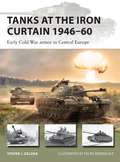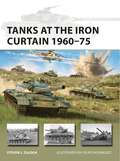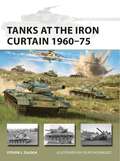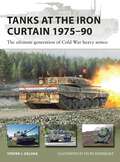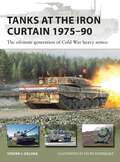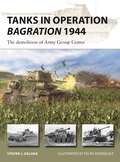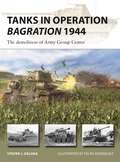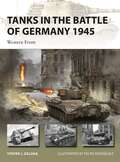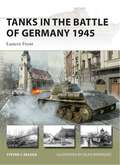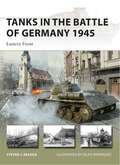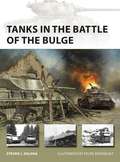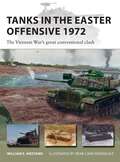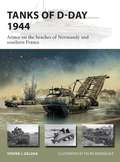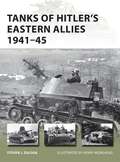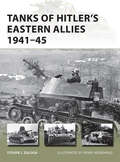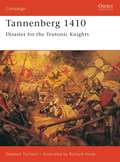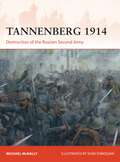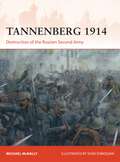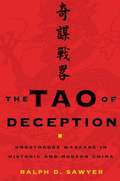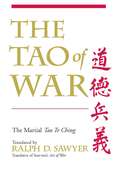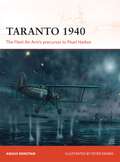- Table View
- List View
Tanks at the Iron Curtain 1946–60: Early Cold War armor in Central Europe (New Vanguard)
by Steven J. ZalogaA study of the Soviet and NATO armored forces that faced each other off in Central Europe in the early Cold War, and how their technology, tactics, and doctrine were all rapidly developed.For 45 years, the most disputed point in the World was the dividing line between East and West in Europe; here the use and development of tanks was key. In this fully illustrated study, author Steve Zaloga, describes how Soviet and NATO tanks were deployed in the early years of the Cold War, and how a generation of tanks such as the Soviet T-44/T-54 and IS-3, British Centurion, US Army M26/M46 Pershing (all developed during World War II) saw extensive service after the war had ended. Initial post-war generation tanks including the Soviet T-54A, T-10 heavy tank, British late-model Centurions, Conqueror, US Army M41, M47, M48 and the French AMX-13 are examined in detail alongside the most important technical trends of the era: the development of shaped-charge anti-tank projectiles, the influence of anti-tank missiles, and the introduction of chemical/nuclear protection and night fighting equipment. The book also considers the influence of post-war doctrine and tactics on tank technology and the effect of regional conflicts such as the 1950 Korean War, the war in Indo-China, and the 1956 Mid East War on tank warfare.
Tanks at the Iron Curtain 1946–60: Early Cold War armor in Central Europe (New Vanguard #301)
by Steven J. ZalogaA study of the Soviet and NATO armored forces that faced each other off in Central Europe in the early Cold War, and how their technology, tactics, and doctrine were all rapidly developed.For 45 years, the most disputed point in the World was the dividing line between East and West in Europe; here the use and development of tanks was key. In this fully illustrated study, author Steve Zaloga, describes how Soviet and NATO tanks were deployed in the early years of the Cold War, and how a generation of tanks such as the Soviet T-44/T-54 and IS-3, British Centurion, US Army M26/M46 Pershing (all developed during World War II) saw extensive service after the war had ended. Initial post-war generation tanks including the Soviet T-54A, T-10 heavy tank, British late-model Centurions, Conqueror, US Army M41, M47, M48 and the French AMX-13 are examined in detail alongside the most important technical trends of the era: the development of shaped-charge anti-tank projectiles, the influence of anti-tank missiles, and the introduction of chemical/nuclear protection and night fighting equipment. The book also considers the influence of post-war doctrine and tactics on tank technology and the effect of regional conflicts such as the 1950 Korean War, the war in Indo-China, and the 1956 Mid East War on tank warfare.
Tanks at the Iron Curtain 1960–75 (New Vanguard)
by Steven J. ZalogaA new analysis of the technology and tanks that faced off against each other on opposite sides of the Iron Curtain, during the very height of the Cold War.From the 1960s onwards, there was a generational shift in tank design and warfare with the advent of CBR (chemical, biological, radiological) protection and a move away from HEAT ammunition to APFSDS. This shift confronted the growing threat of guided anti-tank missiles and saw the introduction of composite armor. Soviet heavy tanks and tank destroyer/assault guns became obsolete, giving way to the technological might of the T-62 and T-64, while NATO forces employed the Chieftain, AMX-30, Leopard I, and M60, plus the initial attempt at a common US-German tank, the MBT-70. Using detailed illustrations and contemporary photographs, this companion volume to NVG 301, Tanks at the Iron Curtain 1946–60 focuses on key battle tanks and their technology to give a comprehensive overall picture of how tanks developed during modern times.
Tanks at the Iron Curtain 1960–75 (New Vanguard)
by Steven J. ZalogaA new analysis of the technology and tanks that faced off against each other on opposite sides of the Iron Curtain, during the very height of the Cold War.From the 1960s onwards, there was a generational shift in tank design and warfare with the advent of CBR (chemical, biological, radiological) protection and a move away from HEAT ammunition to APFSDS. This shift confronted the growing threat of guided anti-tank missiles and saw the introduction of composite armor. Soviet heavy tanks and tank destroyer/assault guns became obsolete, giving way to the technological might of the T-62 and T-64, while NATO forces employed the Chieftain, AMX-30, Leopard I, and M60, plus the initial attempt at a common US-German tank, the MBT-70. Using detailed illustrations and contemporary photographs, this companion volume to NVG 301, Tanks at the Iron Curtain 1946–60 focuses on key battle tanks and their technology to give a comprehensive overall picture of how tanks developed during modern times.
Tanks at the Iron Curtain 1975–90: The ultimate generation of Cold War heavy armor (New Vanguard #323)
by Steven J. ZalogaA comprehensive, illustrated account of the new generation of advanced tanks to emerge during the last 15 years of the Cold War, showcasing major improvements in armor protection, gunsights, and fire-control systems.Focusing on the technology of the period, author Steven J. Zaloga explains how the demands of a potential Cold War battlefield spurred the development of the 20th century's most advanced tanks. He considers the final versions of the Soviet T-72, T-64, and T-80 and assesses their strengths and weaknesses. He also explores how the failure of the US-German MBT-70 project led to America's development of the M1 Abrams tank, and to Germany's all-new Leopard II. The British development of the Challenger tank is also considered, as is the lesser-known Leclerc tank developed by France, the smallest and lightest of any of the western designs. Featuring superbly detailed new illustrations and many photos, this volume pinpoints the key technology of the era, including turbine engines, APFSDS ammunition, advanced armor and high-tech fire-control systems, and describes how the rival tanks compared in the final stretch of the Cold War arms race.
Tanks at the Iron Curtain 1975–90: The ultimate generation of Cold War heavy armor (New Vanguard #323)
by Steven J. ZalogaA comprehensive, illustrated account of the new generation of advanced tanks to emerge during the last 15 years of the Cold War, showcasing major improvements in armor protection, gunsights, and fire-control systems.Focusing on the technology of the period, author Steven J. Zaloga explains how the demands of a potential Cold War battlefield spurred the development of the 20th century's most advanced tanks. He considers the final versions of the Soviet T-72, T-64, and T-80 and assesses their strengths and weaknesses. He also explores how the failure of the US-German MBT-70 project led to America's development of the M1 Abrams tank, and to Germany's all-new Leopard II. The British development of the Challenger tank is also considered, as is the lesser-known Leclerc tank developed by France, the smallest and lightest of any of the western designs. Featuring superbly detailed new illustrations and many photos, this volume pinpoints the key technology of the era, including turbine engines, APFSDS ammunition, advanced armor and high-tech fire-control systems, and describes how the rival tanks compared in the final stretch of the Cold War arms race.
Tanks in Operation Bagration 1944: The demolition of Army Group Center (New Vanguard)
by Steven J. ZalogaA new study of tank warfare used in the Soviet offensive of Operation Bagration, which destroyed Army Group Center. Operation Bagration, the 1944 summer campaign on the Russian Front, has been called “Hitler's Greatest Defeat.” The operation involved substantial tank and armored vehicles on both sides but the German forces were severely hampered by the transfer of dozens of Panzer divisions to France to repel an expected Allied invasion. Forced to make hard decisions, German tank forces in the central Belarus sector were weak compared to the heavy concentration of Panzers in northern Ukraine. The Red Army exploited this vulnerability, crushing Army Group Center, and pushing beyond the Soviet frontier into Poland and East Prussia. With this crucial victory secured, the Red Army conducted successive offensives beyond the Carpathian Mountains, arriving at the Vistula river in Poland, and forcing Romania to switch sides. The Red Army had embarked on a major tank modernization after the Kursk battles of 1943 and as a result, Operation Bagration saw the first widespread use of T-34-85 and IS-2 tanks as well as self-propelled guns. Germany's Panther tank finally reached technical maturity in the summer of 1944 but small numbers weakened its battlefield impact, while other innovations such as the Tiger II heavy tank failed to leave their mark. Using new photos and a fascinating selection of color illustrations explaining the camouflage and markings of these tanks, this book describes how the tanks and AFVs on both sides contributed to the eventual defeat of Army Group Center.
Tanks in Operation Bagration 1944: The demolition of Army Group Center (New Vanguard)
by Steven J. ZalogaA new study of tank warfare used in the Soviet offensive of Operation Bagration, which destroyed Army Group Center. Operation Bagration, the 1944 summer campaign on the Russian Front, has been called “Hitler's Greatest Defeat.” The operation involved substantial tank and armored vehicles on both sides but the German forces were severely hampered by the transfer of dozens of Panzer divisions to France to repel an expected Allied invasion. Forced to make hard decisions, German tank forces in the central Belarus sector were weak compared to the heavy concentration of Panzers in northern Ukraine. The Red Army exploited this vulnerability, crushing Army Group Center, and pushing beyond the Soviet frontier into Poland and East Prussia. With this crucial victory secured, the Red Army conducted successive offensives beyond the Carpathian Mountains, arriving at the Vistula river in Poland, and forcing Romania to switch sides. The Red Army had embarked on a major tank modernization after the Kursk battles of 1943 and as a result, Operation Bagration saw the first widespread use of T-34-85 and IS-2 tanks as well as self-propelled guns. Germany's Panther tank finally reached technical maturity in the summer of 1944 but small numbers weakened its battlefield impact, while other innovations such as the Tiger II heavy tank failed to leave their mark. Using new photos and a fascinating selection of color illustrations explaining the camouflage and markings of these tanks, this book describes how the tanks and AFVs on both sides contributed to the eventual defeat of Army Group Center.
Tanks in the Battle of Germany 1945: Western Front (New Vanguard)
by Steven J. ZalogaThe crossing of the river Rhine marked the beginning of the end of the Third Reich, but the Wehrmacht would fight ferociously on its home soil until the fall of Berlin. The Battle of Germany saw the most advanced tanks of the Allies pitted against the remnants of the once-formidable Panzerwaffe, now exhausted and lacking many of the essentials of armored warfare, but equipped with the biggest and most powerful tanks they would ever field. In these last months the Allies were now equipped with the most advanced Shermans such as the M4A3E8, as well as some of the types that would go on to have successful postwar careers such as the Pershing, Comet, and Chaffee. In contrast the Panzer forces had pinned their hopes on small numbers of monstrous types such as the Jagdtiger and Tiger II, as well as the workhorse Sturmgeschütz and Panzer IVs and Vs. But with German forces crumbling, the Panzerwaffe lacked trained crews, replacement vehicles and fuel, while the Allies' well-supported tank forces advanced through Germany in spectacular combined-arms fashion. Packed with information on tank numbers, types, and comparative performance, this book sheds new light on the two sides' tanks, organization, and doctrine, and explains how the ultimate tank battles of World War II were really fought.
Tanks in the Battle of Germany 1945: Eastern Front (New Vanguard)
by Steven J. ZalogaA new history and analysis of the German and Soviet tank forces that battled on eastern German soil in the final months of World War II.The final months of World War II on the Eastern Front saw the Wehrmacht fighting with exhausted armoured divisions, albeit now armed with the most advanced and heaviest tanks of the war, to slow the Soviet advance. The Red Army meanwhile was rolling relentlessly westwards, with its own highly developed tank forces now equipped with T34/85s and the huge IS-2 heavy tanks, intent on taking Berlin and as much German territory as possible.This book is a history and analysis of the state of these two mighty armoured forces, as their battles decided the fate of Germany. It covers their initial encounters on the German frontier in 1944 (East Prussia), the fighting of the Oder-Vistula offensive in January 1945 and describes the condition of the German tank forces and their Hungarian allies as they were beaten back. It also considers the huge impact of The Red Army and other significant Allied forces such as those from Poland, Czechoslovakia and Romania on the outcome of victory in the war.
Tanks in the Battle of Germany 1945: Eastern Front (New Vanguard)
by Steven J. ZalogaA new history and analysis of the German and Soviet tank forces that battled on eastern German soil in the final months of World War II.The final months of World War II on the Eastern Front saw the Wehrmacht fighting with exhausted armoured divisions, albeit now armed with the most advanced and heaviest tanks of the war, to slow the Soviet advance. The Red Army meanwhile was rolling relentlessly westwards, with its own highly developed tank forces now equipped with T34/85s and the huge IS-2 heavy tanks, intent on taking Berlin and as much German territory as possible.This book is a history and analysis of the state of these two mighty armoured forces, as their battles decided the fate of Germany. It covers their initial encounters on the German frontier in 1944 (East Prussia), the fighting of the Oder-Vistula offensive in January 1945 and describes the condition of the German tank forces and their Hungarian allies as they were beaten back. It also considers the huge impact of The Red Army and other significant Allied forces such as those from Poland, Czechoslovakia and Romania on the outcome of victory in the war.
Tanks in the Battle of the Bulge (New Vanguard)
by Steven J. ZalogaThe Battle of the Bulge raises many questions which, until now, have not been adequately answered: How did the major tank types perform during the battle? What were the specific 'lessons learned' from the combat? And did these lessons result in changes to tanks in the subsequent months? Offering detailed answers to these questions, and many more, this book provides a survey of the principal tank and tank-equivalents (such as tank destroyers and Jagdpanzers) that took part in the Ardennes Campaign of December 1944–January 1945. Beginning with a basic overview of the campaign, accompanied by an order of battle of the major armoured units, it examines the opposing forces, covering the organization of the two tank forces to explain how they were deployed. Author Steven Zaloga also scrutinises the technical balance between the opposing sides, comparing armour, mobility and firepower as well as other important factors such as reliability, crew situational awareness, and tank layout/efficiency. Full of specially commissioned and highly accurate artwork plates of the tanks themselves, as well as fascinating technical data based on cutting-edge research, this title is the definitive guide to tank warfare in the Battle of the Bulge.
Tanks in the Battle of the Bulge: U. S. Army Tank Combat In The European Theater From D-day To The Battle Of Bulge (New Vanguard #281)
by Steven J. ZalogaThe Battle of the Bulge raises many questions which, until now, have not been adequately answered: How did the major tank types perform during the battle? What were the specific 'lessons learned' from the combat? And did these lessons result in changes to tanks in the subsequent months? Offering detailed answers to these questions, and many more, this book provides a survey of the principal tank and tank-equivalents (such as tank destroyers and Jagdpanzers) that took part in the Ardennes Campaign of December 1944–January 1945. Beginning with a basic overview of the campaign, accompanied by an order of battle of the major armoured units, it examines the opposing forces, covering the organization of the two tank forces to explain how they were deployed. Author Steven Zaloga also scrutinises the technical balance between the opposing sides, comparing armour, mobility and firepower as well as other important factors such as reliability, crew situational awareness, and tank layout/efficiency. Full of specially commissioned and highly accurate artwork plates of the tanks themselves, as well as fascinating technical data based on cutting-edge research, this title is the definitive guide to tank warfare in the Battle of the Bulge.
Tanks in the Easter Offensive 1972: The Vietnam War's great conventional clash (New Vanguard)
by William E. HiestandThis study explains how the armies of North and South Vietnam, newly equipped with the most modern Soviet and US tanks and weaponry, fought the decisive armored battles of the Easter Offensive.Wearied by years of fighting against Viet Cong guerillas and North Vietnamese regulars, the United States had almost completely withdrawn its forces from Vietnam by early 1972. Determined to halt the expansion and improvement of South Vietnamese forces under the U.S. “Vietnamization” program, North Vietnam launched a major fourteen-division attack in March 1972 against the South that became known as the “Easter Offensive.” Hanoi's assault was spearheaded by 1,200 tanks and was counteracted on the opposite side by Saigon's newly equipped armored force using U.S. medium tanks. The result was ferocious fighting between major Cold War-era U.S. and Soviet tanks and mechanized equipment, pitting M-48 medium and M-41 light tanks against their T- 54 and PT-76 rivals in a variety of combat environments ranging from dense jungle to urban terrain. Both sides employed cutting-edge weaponry for the first time, including the U.S. TOW and Soviet 9M14 Malyutk wire-guided anti-tank missiles.This volume examines the tanks, armored forces and weapons that clashed in this little-known campaign in detail, using after-action reports from the battlefield and other primary sources to analyze the technical and organizational factors that shaped the outcome. Despite the ARVN's defensive success in October 1972, North Vietnam massively expanded its armor forces over the next two years while U.S. support waned. This imbalance with key strategic misjudgments by the South Vietnamese President led to the stunning defeat of the South in 1975 when T54 tanks crashed through the fence surrounding the Presidential palace and took Saigon on 30 April 1975.
Tanks in the Easter Offensive 1972: The Vietnam War's great conventional clash (New Vanguard #303)
by William E. HiestandThis study explains how the armies of North and South Vietnam, newly equipped with the most modern Soviet and US tanks and weaponry, fought the decisive armored battles of the Easter Offensive.Wearied by years of fighting against Viet Cong guerillas and North Vietnamese regulars, the United States had almost completely withdrawn its forces from Vietnam by early 1972. Determined to halt the expansion and improvement of South Vietnamese forces under the U.S. “Vietnamization” program, North Vietnam launched a major fourteen-division attack in March 1972 against the South that became known as the “Easter Offensive.” Hanoi's assault was spearheaded by 1,200 tanks and was counteracted on the opposite side by Saigon's newly equipped armored force using U.S. medium tanks. The result was ferocious fighting between major Cold War-era U.S. and Soviet tanks and mechanized equipment, pitting M-48 medium and M-41 light tanks against their T- 54 and PT-76 rivals in a variety of combat environments ranging from dense jungle to urban terrain. Both sides employed cutting-edge weaponry for the first time, including the U.S. TOW and Soviet 9M14 Malyutk wire-guided anti-tank missiles.This volume examines the tanks, armored forces and weapons that clashed in this little-known campaign in detail, using after-action reports from the battlefield and other primary sources to analyze the technical and organizational factors that shaped the outcome. Despite the ARVN's defensive success in October 1972, North Vietnam massively expanded its armor forces over the next two years while U.S. support waned. This imbalance with key strategic misjudgments by the South Vietnamese President led to the stunning defeat of the South in 1975 when T54 tanks crashed through the fence surrounding the Presidential palace and took Saigon on 30 April 1975.
Tanks of D-Day 1944: Armor on the beaches of Normandy and southern France (New Vanguard)
by Steven J. ZalogaAllied success in invading Fortress Europe (the area of Continental Europe occupied by Nazi Germany) depended on getting armor onto the beaches as fast as possible. This book explains how the Allies developed the specialist tanks it needed, their qualities, deployment and numbers, and how they performed on the two crucial days when France was invaded, firstly in Normandy and then in Provence. The focus of this volume will be on the specialized tanks developed for the Operation Neptune amphibious landings including the Duplex Drive amphibious Sherman tanks used on both the US and British/Canadian beaches. It also covers the specialized engineer tanks called ”Armoured Funnies” of the British 79th Armoured Division and addresses the popular myth that US Army refusal to employ the Armoured Funnies was a principal cause for the high casualties at Omaha Beach. There is also coverage of Operation Overlord's “Forgotten D-Day”, the amphibious landings of Operation Dragoon. This book addresses why there were so few Panzers opposing the landings from the German perspective as well as detailing the extent of German tank/assault gun activity on D-Day.
Tanks of D-Day 1944: Armor on the beaches of Normandy and southern France (New Vanguard)
by Steven J. ZalogaAllied success in invading Fortress Europe (the area of Continental Europe occupied by Nazi Germany) depended on getting armor onto the beaches as fast as possible. This book explains how the Allies developed the specialist tanks it needed, their qualities, deployment and numbers, and how they performed on the two crucial days when France was invaded, firstly in Normandy and then in Provence. The focus of this volume will be on the specialized tanks developed for the Operation Neptune amphibious landings including the Duplex Drive amphibious Sherman tanks used on both the US and British/Canadian beaches. It also covers the specialized engineer tanks called ”Armoured Funnies” of the British 79th Armoured Division and addresses the popular myth that US Army refusal to employ the Armoured Funnies was a principal cause for the high casualties at Omaha Beach. There is also coverage of Operation Overlord's “Forgotten D-Day”, the amphibious landings of Operation Dragoon. This book addresses why there were so few Panzers opposing the landings from the German perspective as well as detailing the extent of German tank/assault gun activity on D-Day.
Tanks of Hitler’s Eastern Allies 1941–45 (New Vanguard)
by Steven J. Zaloga Henry MorsheadThe titanic armor battles of the Russian Front are widely known, but the role of Germany's eastern allies is not as well known. Two of these countries, Romania and Hungary, manufactured their own tanks as well as purchasing tanks from Germany. These ranged from older, obsolete types such as the PzKpfw 35(t) all the way up to the latest and best German vehicles including the Tiger I and Hetzer. These tanks played a frequent role in the battles in southern Russia and Ukraine and were especially prominent in the disaster at Stalingrad where the Red Army specifically chose the weaker Romanian and Hungarian salients for their critical envelopment operation. This New Vanguard will provide a broad survey of the various and colorful tanks used. Besides covering the largest of these Axis tank forces, this book will cover the many smaller and lesser known forces including the Italian contingent in Russia, the Finnish armored force, and the small but interesting armored forces of the Russian Vlasov (RONA), Croatian, Bulgarian and Slovakian armies. This subject is seeing increasing interest in the modeling world; for example Tamiya recently announced a PzKpfw 35 (t) (suitable for Romanian, Slovak armies) a Finnish StuG III, and a Finnish BT-42.
Tanks of Hitler’s Eastern Allies 1941–45 (New Vanguard #199)
by Steven J. Zaloga Mr Henry MorsheadThe titanic armor battles of the Russian Front are widely known, but the role of Germany's eastern allies is not as well known. Two of these countries, Romania and Hungary, manufactured their own tanks as well as purchasing tanks from Germany. These ranged from older, obsolete types such as the PzKpfw 35(t) all the way up to the latest and best German vehicles including the Tiger I and Hetzer. These tanks played a frequent role in the battles in southern Russia and Ukraine and were especially prominent in the disaster at Stalingrad where the Red Army specifically chose the weaker Romanian and Hungarian salients for their critical envelopment operation. This New Vanguard will provide a broad survey of the various and colorful tanks used. Besides covering the largest of these Axis tank forces, this book will cover the many smaller and lesser known forces including the Italian contingent in Russia, the Finnish armored force, and the small but interesting armored forces of the Russian Vlasov (RONA), Croatian, Bulgarian and Slovakian armies. This subject is seeing increasing interest in the modeling world; for example Tamiya recently announced a PzKpfw 35 (t) (suitable for Romanian, Slovak armies) a Finnish StuG III, and a Finnish BT-42.
Tannenberg 1410: Disaster for the Teutonic Knights (Campaign)
by Stephen Turnbull Richard HookBy 1400 the long running conflict between the Order of Teutonic Knights and Poland and Lithuania was coming to a head, partly as a result of the Order's meddling in the internal politics of its neighbours. In June 1410 King Wladislaw Jagiello of Poland invaded the Order's territory with a powerful allied army including all the enemies of the Teutonic Knights – Poles, Lithuanians, Russians, Bohemians, Hungarians, Tartars and Cossacks. This book recounts how, when the armies clashed on the wooded, rolling hills near the small village of Tannenberg, the Teutonic Knights suffered a disastrous defeat from which their Order never recovered.
Tannenberg 1914: Destruction of the Russian Second Army (Campaign)
by Michael McNallyExplore the Eastern Front battle that resulted in one of the greatest defeats of World War I, in which an entire Russian army was annihilated by German arms.Tannenberg is a major battle that deserves a fully illustrated treatment all of its own, and for the first time this book brings the epic Eastern Front clash to life in visual detail. No other book on this topic walks you through the action like this one, using detailed maps to provide unit locations and movements and help explain key command decisions, while period photographs and colour battlescenes put soldiering back at the core of the events by revealing the military material culture of the opposing sides. Michael McNally guides you through the initial border engagements and the battles of Gumbinnen and Stallupönen, before moving on to explore the massive, often confused running battle of Tannenberg in easy to follow and concise detail. This work helps you understand how the Germans managed to maul Samsonov's Second Army and all but destroyed the Russians as a fighting force. The Russian war plan of using overwhelming numbers to gain a quick victory before conducting further operations would soon lie in pieces on the ground. It also assesses the contribution modern technology – such as railways, aerial reconnaissance, radio and telegraphy – made to the emphatic German victory.
Tannenberg 1914: Destruction of the Russian Second Army (Campaign)
by Michael McNallyExplore the Eastern Front battle that resulted in one of the greatest defeats of World War I, in which an entire Russian army was annihilated by German arms.Tannenberg is a major battle that deserves a fully illustrated treatment all of its own, and for the first time this book brings the epic Eastern Front clash to life in visual detail. No other book on this topic walks you through the action like this one, using detailed maps to provide unit locations and movements and help explain key command decisions, while period photographs and colour battlescenes put soldiering back at the core of the events by revealing the military material culture of the opposing sides. Michael McNally guides you through the initial border engagements and the battles of Gumbinnen and Stallupönen, before moving on to explore the massive, often confused running battle of Tannenberg in easy to follow and concise detail. This work helps you understand how the Germans managed to maul Samsonov's Second Army and all but destroyed the Russians as a fighting force. The Russian war plan of using overwhelming numbers to gain a quick victory before conducting further operations would soon lie in pieces on the ground. It also assesses the contribution modern technology – such as railways, aerial reconnaissance, radio and telegraphy – made to the emphatic German victory.
The Tao of Deception: Unorthodox Warfare in Historic and Modern China
by Ralph D. SawyerThe history of China is a history of warfare. Wars have caused dynasties to collapse, fractured the thin façade of national unity, and brought decades of alien occupation. But throughout Chinese history, its warfare has been guided by principles different from those that governed Europe. Chinese strategists followed the concept, first articulated by Sun-tzu in The Art of War, of qi (ch'i), or unorthodox, warfare. The concept of qi involves creating tactical imbalances in order to achieve victory against even vastly superior forces. Ralph D. Sawyer, translator of The Art of War and one of America's preeminent experts on Chinese military tactics, here offers a comprehensive guide to the ancient practice of unorthodox warfare. He describes, among many other tactics, how Chinese generals have used false rumors to exploit opposing generals' distrust of their subordinates; dressed thousands of women as soldiers to create the illusion of an elite attack force; and sent word of a false surrender to lure enemy troops away from a vital escape route. The Tao of Deception is the book that military tacticians and military historians will turn to as the definitive guide to a new, yet ancient, way of thinking about strategy.
The Tao Of War: The Martial Tao Te Ching
by Ralph D. SawyerWang Chen, a ninth-century military commander, was sickened by the carnage that had plagued the glorious T'ang dynasty for decades. "All within the seas were poisoned," he wrote, "and pain and disaster was rife throughout the land." Wang Chen wondered, how can we end conflicts before they begin? How can we explain and understand the dynamics of conflict? For the answer he turned to a remarkable source-the Tao Te Ching. Here is Wang Chen's own rendering of and commentary on the ancient text, insightfully expanded and amplified by translator Ralph D. Sawyer, a leading scholar of Chinese military history.Although the Tao long influenced Chinese military doctrine, Wang Chen's interpretations produced the first reading of it as a martial text-a "tao of war." Like Sun-tzu's Art of War, certainly the most famous study of strategy ever written, the Tao provides lessons for the struggles of contemporary life. In the way that the ancient Art of War provides inspiration and advice on how to succeed in competitive situations of all kinds, even in today's world, Wang Chen's The Tao of War uncovers action plans for managing conflict and promoting peace. A book to put on the shelf next to Art of War, Wang Chen's The Tao of War is a reference of equally compelling and practical advice.
Taranto 1940: The Fleet Air Arm’s precursor to Pearl Harbor (Campaign #288)
by Peter Dennis Angus KonstamThe Royal Navy's attack on Taranto in 1940 heralded a new age of warfare. It was the decisive moment in a struggle for dominance of the Mediterranean that had gone on for months, as the British and Italian navies both looked to secure maritime supply routes for their colonies. With the enormous demands of a global war beginning to tell, the British capital ships were simply too thinly spread for a large fleet action against Taranto, where the bulk of the Italian fleet lay menacingly. How was the Royal Navy to eliminate the threat of the Regia Marina? This is the story of one of World War II's most devastating raids, recounting how a handful of obsolete Fairey Swordfish biplanes swooped in and destroyed an Italian battleship and badly damaged two more. With expert analysis, detailed colour illustrations and a gripping narrative, this book explains the origins of the attack, its planning and execution, and what happened in the aftermath.
